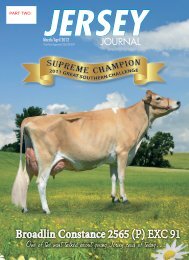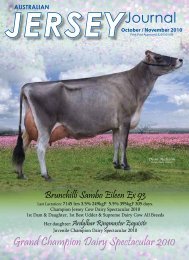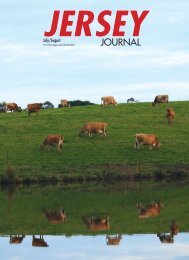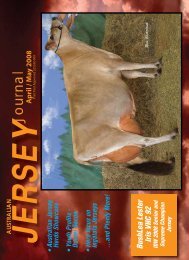Australian Dairy Herd Improvement Report 2010.pdf
Australian Dairy Herd Improvement Report 2010.pdf
Australian Dairy Herd Improvement Report 2010.pdf
You also want an ePaper? Increase the reach of your titles
YUMPU automatically turns print PDFs into web optimized ePapers that Google loves.
2010 In Review<br />
NHIA activities<br />
By Carol Millar<br />
NHIA General<br />
Manager<br />
The <strong>Dairy</strong> Industry Data Project <strong>Report</strong> 2010 is a<br />
landmark publication for the herd improvement<br />
industry and represents the most comprehensive<br />
examination of the state of dairy data ever done in<br />
Australia. For that reason, it is worthwhile to review<br />
the contents of this report which was prepared by<br />
independent consultancy firm, GHD.<br />
Context<br />
“We believe that the time is right for the <strong>Australian</strong><br />
dairy industry to make a significant effort to adopt a<br />
dairy data system that is world’s best practice, which<br />
enables dairy farmers to make informed and timely<br />
management decisions on their farms,”<br />
Dr Shaffer, NHIA Working Group Chairman<br />
There is an overwhelming consensus between<br />
dairy industry stakeholders that the way dairy<br />
data is currently exchanged limits potential<br />
productivity gains from herd improvement for the<br />
<strong>Australian</strong> dairy industry.<br />
The profitability and international<br />
competitiveness of the <strong>Australian</strong> dairy industry<br />
depends on a continual improvement in dairy<br />
herd data. The industry has made a substantial<br />
investment to build a body of high-quality<br />
scientific knowledge with the expectation<br />
that this will underpin decisions regarding the<br />
selection of desirable traits.<br />
Repositioning dairy data exchange into a<br />
pre-competitive setting is essential to support<br />
research, improve genetic evaluation and<br />
underpin information product innovation across<br />
the industry to realise productivity gains through<br />
better on-farm decision making. This report has<br />
found that Australia could achieve gains of<br />
$10-$50 million during the next 10 years if<br />
farm-level data management was improved.<br />
Key Issues<br />
Five main drivers that are both supporting and,<br />
in some cases, inhibiting improvements in dairy<br />
data collection, transfer and access are identified<br />
in the report. These are: better decision-making<br />
information; sustaining genetic evaluation data<br />
flows; rationalisation; innovation and technology;<br />
and regulatory and market compliance.<br />
The report identifies three value chains for dairy<br />
data: herd recording; breeding, fertility and<br />
herd management; and food and safety/quality<br />
and environment, for which challenges and<br />
opportunities are identified. Many of the existing<br />
gaps and issues identified are concerned mainly<br />
with the quality and quantity of data, particularly<br />
relating to collection and integration.<br />
The main challenges identified include:<br />
• lack of industry leadership to address data issues<br />
and realise productivity gains;<br />
• multiple animal ID processes and numbers with<br />
calls for implementing a unique recognised<br />
animal ID system;<br />
• gaps in data, value-adding constrained;<br />
• fragmented systems, difficulties in data transfer<br />
and sharing;<br />
• less than optimal data collection processes and<br />
adoption of new technologies;<br />
• reduced data flow through the data value chains;<br />
• improvements in reliability of genetic evaluation;<br />
• data not valued by all stakeholders; and<br />
• incentives for data collection not aligned with<br />
benefits of data use.<br />
These challenges present opportunities to the<br />
industry for improvement in dairy data collection,<br />
transfer and access. These opportunities can be<br />
pursued and challenges addressed by a mixture<br />
of education; regulation push and market pull to<br />
establish the elements of a desirable system as<br />
outlined by stakeholders.<br />
4 <strong>Australian</strong> <strong>Dairy</strong> <strong>Herd</strong> <strong>Improvement</strong> <strong>Report</strong> 2010

















